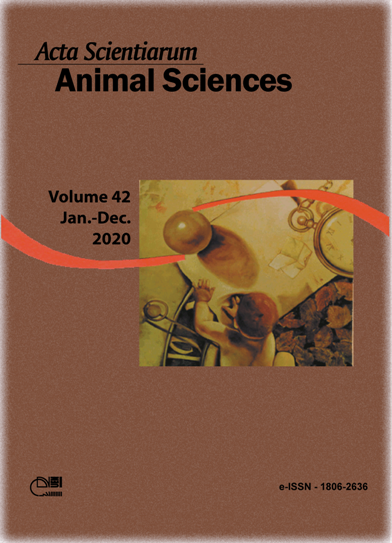Digestible lysine requirement for European laying quail
Resumo
The experiment was carried out to evaluate the productive performance of European quails (Coturnix coturnix) in the production phase, fed with diets containing different levels of digestible lysine. A total of 175 female quails, aged 65 days, were randomly distributed in a completely randomized design with five treatments and five replicates per treatment. The animals were housed in 25 metal cages, and each cage represented an experimental parcel, with seven birds per parcel. The birds were fed the experimental rations containing 1.177, 1.217, 1.317, 1.417, and 1.517% digestible lysine. The parameters evaluated were: laying rate, mass of eggs produced, feed intake in the period, lysine intake, feed conversion per dozen and per mass. Significant differences were observed for posture rate with quadratic behavior, which indicated higher production for the level of 1.23% of digestible lysine. There was an increasing linear behavior for the feed and lysine intake, and for conversion feed per dozen and by mass, we observed quadratic behaviors. This indicates better feed conversion index when the optimal inclusion level was 1.33% and 1.404% of digestible lysine in the diet, respectively. The requirement of digestible lysine in diets for European quails is 1.404%, which corresponds to a daily intake of 421.20 milligrams of digestible lysine.
Downloads
Referências
Barreto, S. L. T., Araujo, M. S., Umigi, R. T., Donzele, J. L., Rocha, T. C., Pinheiro, S. R. F., ... Silva, R. F. (2006). Exigência nutricional de lisina para codornas européias machos de 21 a 49 dias de idade. Revista Brasileira de Zootecnia, 35(3), 750-753. doi: 10.1590/S1516-35982006000300016
Costa, F. G. P., Rodrigues, V. P., Goulart, C. C., Lima Neto, R. C., Souza, J. G., & Silva, J. H. V. (2008). Exigências de lisina digestível para codornas japonesas na fase de postura. Revista Brasileira de Zootecnia, 37(12), 2136-2140. doi: 10.1590/S1516-35982008001200009
Della-Flora, R. P., Germano, J. M., Bavaresco, C., Lacerda, V., & Dionello, N. J. L. (2012). Exigência nutricional de lisina para matrizes de codornas de corte. PUBVET, 6(29), 1-15.
Drumond, E. S. C., Moreira, J., Veloso, R. C., Pires, A. V., Amaral, J. M., Gonçalves, F. M., & Balotin, L. V. (2013). Curvas de crescimento para codornas de corte. Ciência Rural, 43(43), 1872-1877. doi: 10.1590/S0103-84782013001000023
Fernandez, I. B., Calixto, L. F. L., Torres-Cordido, K. A. A., Lemos, M. J., Togashi, C. K., Souza, D. S., ... Pizzolante, C. C. (2018). Feeding time under performance and eggs quality of quails in production. Revista Brasileira de Saúde e Produção Animal, 19(1), 136-143. doi: 10.1590/S1519-99402018000100013
Jordão Filho, J., Silva, J. H. V. d., Silva, C. T., Costa, F. G. P., Sousa, J. M. B., & Givisiez, P. E. N. (2011). Energy requirement for maintenance and gain for two genotypes of quails housed in different breeding rearing systems. Revista Brasileira de Zootecnia, 40(11), 2415-2422. doi: 10.1590/S1516-35982011001100019
Lima, H. J. D., Barreto, S. L. T., Donzele, J. L., Souza, G. S., Almeida, R. L., Tinoco, I. F. F., & Albino, L. F. T. (2016). Digestible lysine requirement for growing Japanese quails. The Journal of Applied Poultry Research, 25(4), 483-491. doi: 10.3382/japr/pfw030
Lucena, L. R. R., Holanda, M. A. C., Holanda, M. C. R., & Anjos, M. L. (2019). Adjusting weight growth curve of male quails Coturnix japonica reared in the semi-arid region of the State of Pernambuco. Acta Scientiarum. Animal Sciences, 41(e42563). doi: 10.4025/actascianimsci.v41i1.42563
Nery, V. L. H., Castro, L. G., & Novoa, D. M. T. (2015). Digestible lys ine levels for japanese quail in laying phase. Revista de la Facultad de Medicina Veterinaria y de Zootecnia, 62(3), 49-57. doi: 10.15446/rfmvz.v62n3.54941
Ribeiro, C. L. N., Barreto, S. L. d. T., Reis, R. d. S., Muniz, J. C. L., Donzele, J. L., Gomes, P. C., ... Albino, L. F. T. (2013). Digestible lysine levels in diets for laying Japanese quails. Revista Brasileira de Zootecnia, 42(7), 489-495. doi: 10.1590/S1516-35982013000700005
Rostagno, H. S., Albino, L. F. T., Donzele, J. L., Gomes, P. C., Oliveira, R., Lopes, D. C., . Euclides, R. F. (2017). Composição de alimentos e exigências nutricionais (3a ed. Vol. 1). Viçosa, MG: Universidade Federal de Viçosa.
Silva, W. A., Elias, A. H. N., Aricetti, J. A., Sakamoto, M. I., Murakami, A. E., Gomes, S. T. M., ... Matsushita, M. (2009). Quail egg yolk (Coturnix coturnix japonica) enriched with omega-3 fatty acids. Food Science and Technology, 42(2), 660-663. doi: 10.1016/j.lwt.2008.08.005
Ton, A. P. S., Furlan, A. C., Martins, E. N., Toledo, J. B., Scherer, C., & Conti, A. C. M. (2011). Exigências de lisina digestível e de energia metabolizável para codornas de corte em crescimento. Revista Brasileira de Zootecnia, 40(3), 593-601. doi: 10.1590/S1516-35982011000300018
DECLARAÇÃO DE ORIGINALIDADE E DIREITOS AUTORAIS
Declaro que o presente artigo é original, não tendo sido submetido à publicação em qualquer outro periódico nacional ou internacional, quer seja em parte ou em sua totalidade.
Os direitos autorais pertencem exclusivamente aos autores. Os direitos de licenciamento utilizados pelo periódico é a licença Creative Commons Attribution 4.0 (CC BY 4.0): são permitidos o compartilhamento (cópia e distribuição do material em qualqer meio ou formato) e adaptação (remix, transformação e criação de material a partir do conteúdo assim licenciado para quaisquer fins, inclusive comerciais.
Recomenda-se a leitura desse link para maiores informações sobre o tema: fornecimento de créditos e referências de forma correta, entre outros detalhes cruciais para uso adequado do material licenciado.








































